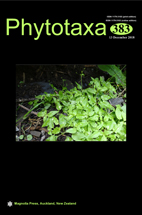Abstract
To test the taxonomic significance of secondary chemistry (particularly lobaric acid and fatty acids) and pruina in Parmelia ernstiae, P. saxatilis, P. serrana, P. submontana and P. sulcata in Europe, 3684 specimens were analysed morphologically and chemically, and 82 ITS rDNA sequences were prepared. A comparison of the resulting phylogram with the production of secondary metabolites (P. saxatilis group) and the intensity and presence of the thallus pruina (all five species) show that lobaric acid occurs in only three species, P. ernstiae, P. saxatilis and P. serrana, but its presence is variable within them. Fatty acids are restricted to P. ernstiae and P. serrana. All studied species can develop epruinose to strongly pruinose thalli, and therefore pruina is an uninformative character at species level. The traits reliable for the determination of the species are the type of vegetative propagules, their placement on the thallus, and the lobe shape. It was previously suggested that the development of pruina may depend on light intensity, but epruinose and pruinose thalli of the same species were often found growing side by side in exactly the same environmental conditions. Thalli differing in pruina intensity might contain different photobiont strains.

